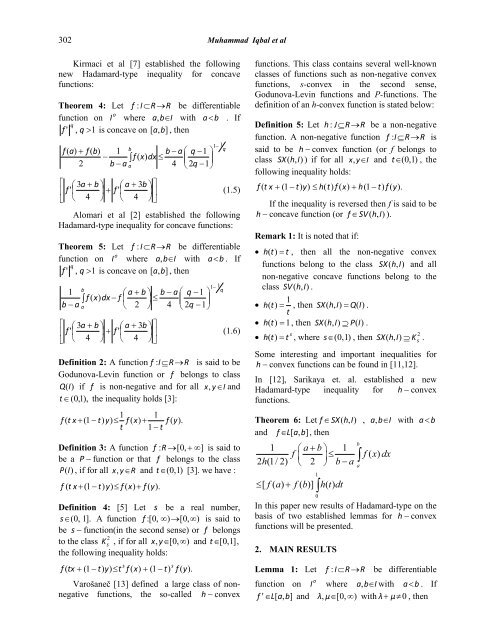Download Full Journal - Pakistan Academy of Sciences
Download Full Journal - Pakistan Academy of Sciences
Download Full Journal - Pakistan Academy of Sciences
You also want an ePaper? Increase the reach of your titles
YUMPU automatically turns print PDFs into web optimized ePapers that Google loves.
302 Muhammad Iqbal et al<br />
Kirmaci et al [7] established the following<br />
new Hadamard-type inequality for concave<br />
functions:<br />
Theorem 4: Let f : I RR<br />
be differentiable<br />
function on I o where a, bI<br />
with a b . If<br />
q<br />
f ' , q 1<br />
is concave on [ a , b]<br />
, then<br />
b<br />
f(<br />
a)<br />
f ( b)<br />
1<br />
b a q 1<br />
<br />
f ( x)<br />
dx <br />
2 b a a 4 2q<br />
1<br />
1<br />
1<br />
q<br />
3a<br />
b a 3b<br />
<br />
f ' f ' <br />
(1.5)<br />
4 4 <br />
Alomari et al [2] established the following<br />
Hadamard-type inequality for concave functions:<br />
Theorem 5: Let f : I RR<br />
be differentiable<br />
function on I o where a, bI<br />
with a b . If<br />
q<br />
f ' , q 1<br />
is concave on [ a , b]<br />
, then<br />
1<br />
b<br />
<br />
<br />
<br />
a b <br />
b<br />
f ( x)<br />
dx f <br />
a<br />
a 2<br />
<br />
<br />
<br />
<br />
<br />
b a q 1<br />
<br />
<br />
4 2q<br />
1<br />
1<br />
1<br />
q<br />
3a<br />
b a 3b<br />
<br />
f ' f ' <br />
(1.6)<br />
4 4 <br />
Definition 2: A function f : I RR<br />
is said to be<br />
Godunova-Levin function or f belongs to class<br />
Q (I) if f is non-negative and for all x, yI<br />
and<br />
t (0,1), the inequality holds [3]:<br />
1 1<br />
f ( t x (1 t)<br />
y)<br />
f ( x)<br />
f ( y).<br />
t 1 t<br />
Definition 3: A function f : R [0,<br />
]<br />
is said to<br />
be a P function or that f belongs to the class<br />
P (I) , if for all x, yR<br />
and t (0,1)<br />
[3]. we have :<br />
f ( t x (1<br />
t)<br />
y)<br />
f ( x)<br />
f ( y).<br />
Definition 4: [5] Let s be a real number,<br />
s (0, 1]. A function f :[0,<br />
)<br />
[0,<br />
)<br />
is said to<br />
be s function(in the second sense) or f belongs<br />
2<br />
to the class K s , if for all x , y[0,<br />
)<br />
and t[0,1] ,<br />
the following inequality holds:<br />
s<br />
f ( tx (1 t)<br />
y)<br />
t<br />
f ( x)<br />
(1 t)<br />
f ( y).<br />
Varošane [13] defined a large class <strong>of</strong> nonnegative<br />
functions, the so-called h convex<br />
s<br />
functions. This class contains several well-known<br />
classes <strong>of</strong> functions such as non-negative convex<br />
functions, s-convex in the second sense,<br />
Godunova-Levin functions and P-functions. The<br />
definition <strong>of</strong> an h-convex function is stated below:<br />
Definition 5: Let h : JRR<br />
be a non-negative<br />
function. A non-negative function f : I RR<br />
is<br />
said to be h convex function (or f belongs to<br />
class SX ( h,<br />
I)<br />
) if for all x, yI<br />
and t (0,1)<br />
, the<br />
following inequality holds:<br />
f ( t x (1 t)<br />
y)<br />
h(<br />
t)<br />
f ( x)<br />
h(1<br />
t)<br />
f ( y).<br />
If the inequality is reversed then f is said to be<br />
h concave function (or f SV( h,<br />
I)<br />
).<br />
Remark 1: It is noted that if:<br />
h( t)<br />
t , then all the non-negative convex<br />
functions belong to the class SX ( h,<br />
I)<br />
and all<br />
non-negative concave functions belong to the<br />
class SV ( h,<br />
I)<br />
.<br />
1<br />
h( t)<br />
, then SX( h,<br />
I)<br />
Q(<br />
I)<br />
.<br />
t<br />
h ( t)<br />
1, then SX( h,<br />
I)<br />
P(<br />
I)<br />
.<br />
s<br />
2<br />
( h,<br />
I)<br />
K s<br />
h( t)<br />
t , where s (0,1)<br />
, then SX .<br />
Some interesting and important inequalities for<br />
h convex functions can be found in [11,12].<br />
In [12], Sarikaya et. al. established a new<br />
Hadamard-type inequality for h convex<br />
functions.<br />
Theorem 6: Let f SX( h,<br />
I)<br />
, a, bI<br />
with a b<br />
and f L[ a,<br />
b]<br />
, then<br />
1 a<br />
b 1<br />
f <br />
2 h(1/2) 2 b<br />
a<br />
[ f( a) f( b)] h( t)<br />
dt<br />
1<br />
<br />
0<br />
b<br />
<br />
a<br />
f( x)<br />
dx<br />
In this paper new results <strong>of</strong> Hadamard-type on the<br />
basis <strong>of</strong> two established lemmas for h convex<br />
functions will be presented.<br />
2. MAIN RESULTS<br />
Lemma 1: Let f : I RR<br />
be differentiable<br />
o<br />
function on I where a, bI<br />
with a b . If<br />
f ' L[<br />
a,<br />
b]<br />
and , [0,<br />
)<br />
with 0<br />
, then

















